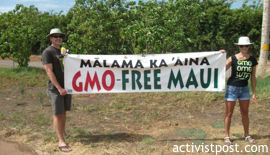 In the 1960s, researchers discovered that planting crops in Hawaii resulted in growth three times faster than in other states on the mainland, the biggest crop of which continues to be corn. Since then, Hawaii has largely become a testing ground for new varieties of crops, most of which are genetically engineered and modified to kill or deter insects while still producing a large amount of edible crops for human consumption.
In the 1960s, researchers discovered that planting crops in Hawaii resulted in growth three times faster than in other states on the mainland, the biggest crop of which continues to be corn. Since then, Hawaii has largely become a testing ground for new varieties of crops, most of which are genetically engineered and modified to kill or deter insects while still producing a large amount of edible crops for human consumption.
What’s the Problem?
Basically, genetically modified organisms (GMOs), which are now found in 90% of our processed foods and 100% of the grain fed to the non-organic meat we consume, may be bad for us. But that’s still up for debate.
The first real problem is that these genetically modified seeds can be patented as intellectual property, allowing corporate giants like Bayer Cropscience, Dow AgroSciences, BASF, Syngenta AG, Pioneer HI-Bred International and the top dog, Monsanto – formerly a “Chemical Company”, now a “Bio-Agricultural Company” – the ability to own, sell, and control GMO crops with no liability for any negative effects they might be causing. Convenient, eh?
That’s really only the beginning, however. The FDA, USDA and Washington D.C. all seem to be in favor of GMO crops, reporting that the effects from these chemicals are of no great concern. Much like choosing the parent that offers allowance and candy instead of chores and brussel sprouts, there’s a revolving door that often opens up not-so-subtle trails of money, great insight as to why many leading companies and politicians, who perhaps should be concerned about the possible health effects of these crops, are turning their heads.
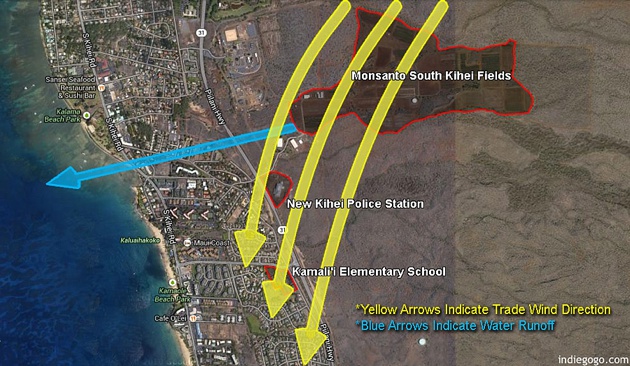
In fact, just last year, the “Monsanto Protection Act” (HR 933) was passed, officially allowing Monsanto to plant GMO crops in areas across the country without any actual proof of the health effects the crops have on humans. In addition, it officially bars federal courts from being able to stop the sale or planting of GMO seeds, no matter what health issues arise in the future. Not only did Monsanto contribute in writing the language to its own legislation (once again, how convenient), but it appears that many members of Congress were unaware that the provision was even in the legislation at all. While the expiration date of the bill is set for December 2015, it doesn’t set a good tone for those opposed to the power of GMO giants.
Glyphosate, the main ingredient in most herbicides in the world, including Roundup, the weedkiller owned and sold by Monsanto, was detected in 3/10 American women’s breast milk sampled by Mothers Across America. While the FDA and EPA reported that these levels were insignificant and safe, it becomes increasingly harder to know which companies to trust, especially when those telling you that everything is fine are simultaneously cashing checks from the companies in danger. Another study reported that Glyphosate levels in American urine tests were “over 10 times higher than those in Europe” and “detectable in 70% of household drinking water.” While many argue whether or not Glyphosate is bad for you, the one clear answer is that it’s already there.
Many concerned parties have also brought up the fact that employees hired to spray these pesticides are required to wear head-to-toe protective gear, including respirators. What happens, for example, when residents down the street are forced to inhale the same toxins without the same protective gear? The map below shows the countries in which GMO food is required to be labeled, another hot topic for those concerned about what they’re currently consuming and how they can avoid further potential health effects.
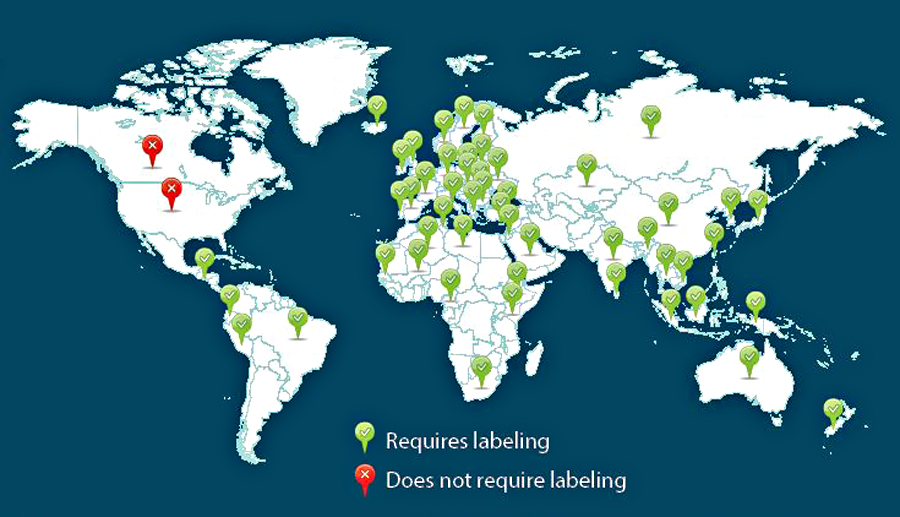
While Glyphosate is still the main concern in terms of chemical consumption, new forms of weeds and insects have become resistant to Glyphosate (aloha, evolution), forcing companies to use another type of herbicide known as 2,4-D, recently approved by the USDA and currently being tested on Maui’s neighbor island of Molokai.
Statewide Initiatives
Kauai
With only 67,000 residents, The Garden Isle enjoys relative calm and untouched beauty compared to it’s much more populous neighbor of Oahu. But beneath its rugged beauty, Kauai is fighting a very important battle against large GMO corporations.
 In 2000, the EPA canceled the use of chlorpyrifos, the active chemical ingredient in many pesticides, for homeowner use both inside and outside due to documented findings of the developmental risks it poses for children. What the ruling failed to limit, however, was its use by corporations, including those on Kauai that spray almost daily near schools, homes and medical facilities. When students at Waimea Canyon Middle School began complaining of symptoms like nausea, dizziness, disorientation and headaches, it was found that chlorpyrifos was drifting into the school from nearby crop fields of DuPont Pioneer. The University of Hawaii tested air samples between 2010 and 2012 and found the chemical present every single time.
In 2000, the EPA canceled the use of chlorpyrifos, the active chemical ingredient in many pesticides, for homeowner use both inside and outside due to documented findings of the developmental risks it poses for children. What the ruling failed to limit, however, was its use by corporations, including those on Kauai that spray almost daily near schools, homes and medical facilities. When students at Waimea Canyon Middle School began complaining of symptoms like nausea, dizziness, disorientation and headaches, it was found that chlorpyrifos was drifting into the school from nearby crop fields of DuPont Pioneer. The University of Hawaii tested air samples between 2010 and 2012 and found the chemical present every single time.
The Kauai Agricultural Good Neighbor Program, which went into effect on December 1, 2013, currently requires Dow AgroSciences, DuPont Pioneer, Syngenta, BASF and Kauai Coffee Company to report the type of restricted use pesticides (RUP) applied to the fields on Kauai each month and implement a 100 foot buffer zone between schools, medical facilities and residential properties. The program will be reviewed at the year mark for further assessment.
In November 2013, Kauai County Ordinance 960 was passed, which would require corporations to comply with chemical buffer zones of 500 feet around hospitals, residences and schools. In addition, the ordinance also required disclosure of all GMO crops and pesticide use so that people could fairly avoid exposure to harmful chemicals. As expected, the chemical companies did not agree with the new restrictions, reacting swiftly by suing Kauai County for the right to continue spraying chemicals without disclosure and without complying to the higher buffer zone area.
In August, U.S. Magistrate Judge Barry Kurren sided with the chemical companies, effectively stopping the ordinance from going into effect due to counties not having the proper authority to regulate agriculture already covered under state and federal laws.
In a further attempt to shed light on this issue, pro surfer, MMA fighter and political activist Dustin Barca, who was born and raised on Kauai, is running for Mayor. Backed by pro surfers like Kelly Slater, Barca is on a mission to change the future of sustainable and safe agriculture on Kauai.
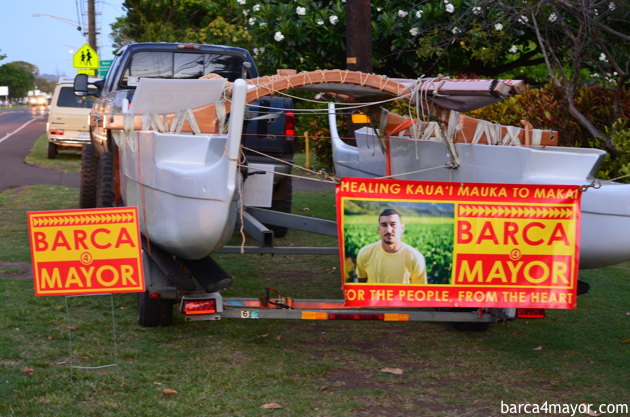
Big Island
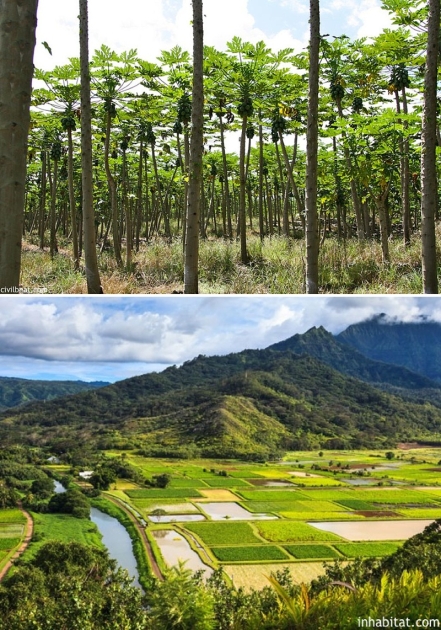 In late 2013, Hawaii County Mayor Billy Kenoi signed Bill 113 into law, which effectively bans biotech companies from operating on the Big Island and farmers from testing or growing any new genetically modified crops (with the exception of papayas). As a step toward encouraging community-based farming and ranching, the ban also includes stiff fines of $1,000/day for violators.
In late 2013, Hawaii County Mayor Billy Kenoi signed Bill 113 into law, which effectively bans biotech companies from operating on the Big Island and farmers from testing or growing any new genetically modified crops (with the exception of papayas). As a step toward encouraging community-based farming and ranching, the ban also includes stiff fines of $1,000/day for violators.
Many Big Island farmers and flower growers, however, in addition to Biotechnology Industry Organization, the trade association that represents corporate giants like Monsanto, filed a lawsuit challenging the ban on genetically modified farming, stating that it’s backed by no scientific evidence and violates state and federal laws. Genetically modified farming, they argue, is a “critical and generally accepted part of agriculture.” Judge Barry Kurren, the same judge that ruled against the Kauai County Ordinance, will hear oral arguments on whether to dismiss or uphold the law on October 23rd.
What’s Next for Maui County?
Maui County is currently at a crossroads that will officially face off on November 4th. An initiative titled “A Bill Placing a Moratorium on the Cultivation of Genetically Engineered Organisms”, which calls for a temporary halt in the growth, testing and cultivation of all GMOs on Maui until public health and environmental impact studies are conducted, is the first time in Maui’s history that citizens have been able to collect enough signatures – 9,062 in total – to get an initiative on the ballot.
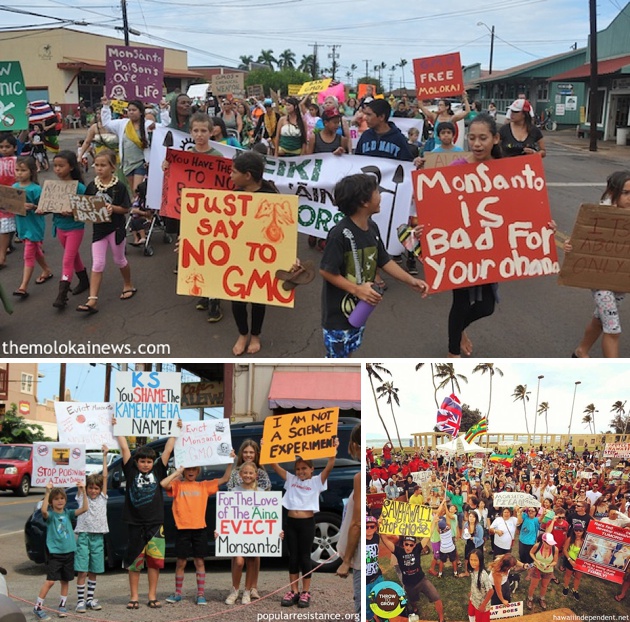
But not everyone is on board with the proposed initiative. CAMCFB, or Citizens Agains the Maui County Farming Ban (can we get an initiative for a catchier name, anyone?), are calling for a vote against the proposed moratorium. Started by Adolth Helm, Project Manager at Dow AgroSciences, one of two GMO companies currently growing crops in Maui County, claimed the title of the proposed initiative was “misleading, confusing and deceptive towards voters,” filing a lawsuit which was ruled down by Judge Rhonda Loo on September 15th.
Nancy K. Johnson, a supporter of CAMCFB and a Nursing Professor at Maui College, says she “feels comfortable that there is not a health risk from eating foods that are produced using genetic modification” and “people that are concerned about it… could choose to eat other foods.” That’s all well and good, Nancy, but rather difficult to do when companies aren’t required to label their food as GMO.
GMO corporations aren’t the only ones opposed to the idea, however. Many local farmers have been told that the ‘anti-farming’ initiative will cost Maui County 600 jobs in addition to preventing them from using similar pesticides to control their own crops, even facing threats of harsh fines for doing so.
Bruce Douglas, co-founder of the Shaka Movement and co-author of the initiative, however, assures voters that CAMCFB is simply a “Monsanto front group” allowing the spread of false information without any opportunity for liability. He says the initiative would not impact anyone not directly working for Monsanto and believes they’re simply lying about the threat of job losses.
Ashley Lukens, Hawaii Center for Food Safety Director, points out that “Hawaii hosts more genetic engineering test sites than any other state. We had 1,124 field tests last year. California had 184.” If you’re for the halt of GMOs until proper studies are conducted, vote yes on November 4th. If you’re against it, vote no. Whatever happens, next month will be a turning point in the way Maui, and by extension the state and country, allow GMOs to affect their food industry.
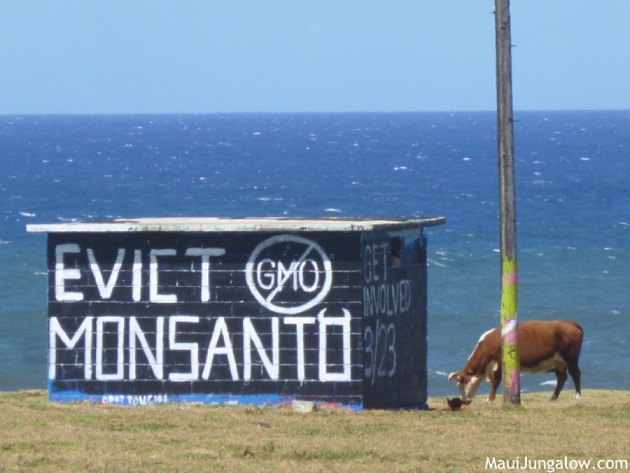
Sources:
https://themindunleashed.org/2014/09/monsanto-annihilated-paradise-turned-island-death.html
https://gmo-awareness.com/all-about-gmos/gmo-defined/
https://www.civilbeat.com/2014/06/hawaii-farmers-biotech-industry-challenge-big-islands-gmo-ban/
https://ecowatch.com/2014/08/05/fight-over-moratorium-gmo-hawaii-big-island/
Disclaimer: All sources and information are deemed reliable, but we cannot guarantee accuracy. Please note that this article is purely informational and should not be construed as part of any political agenda.


im all for labeling but I think im gonna vote no on the outright ban on Nov 4. Its just to all encompassing. im for control, carefulness, and def labeling but there is more nuance to the issue in saving certain crops/industies (eg, the papaya crops here and feeding the growing poulation of the world. its easy for us privledged ones to get on our high horses while we throw away excess food…not true for some who would love gmo processes to help them not starve to death
I would like to know if all the pesticides and weed killers drifting over the communities are harmless or not. If the bill requires testing of the air we breathe downwind of these possible poison cocktails then it would seem that everyone would like to know the truth. If it is harmless , then Monsanto will survive the scrutiny. Vote to test the air we breathe I say.
Hi,
I think you have some good information here. I’m definitely voting YES. It’s time to value the health of people and our environment before corporate greed. As my daughter in 2nd grade asked me very innocently today, “Mom, why don’t they use all the money they are putting into advertising the dishonest ads into just doing the safety tests that need to be done?”
One think I would like to see the Anti-GMO, Anti-Unsafe Pesticides groups answer clearly, though, is the issue of the actual implications and cost of the initiative once we pass it. I think someone really sharp needs to combat each and every pseudo argument popping up in the propaganda ads. Can someone clarify what it will actually cost the county to implement this moratorium? Can someone re-articulate what I think I read in the actual initiative, which is that the companies (Monsanto, etc.) will have to pay for the environmental impact and safety tests required, NOT the county?
We need someone to dismantle each and every bit of the propaganda if we are too pass this on Nov. 4th.
Thanks for your voice and your webpage. Diana
The Kauai ordinance provides for a buffer zone of only 100 feet?! Oh, yeah, as if that’ll keep the shit out of the air we’re breathing. How about expanding the minimum buffer zone to 1,000 miles?! And, too, I wonder how the proposed restrictions for Maui are supposed to be practical and effective if the satanic petro-chem corporations will be required go pay for it?!…How is that supposed to work, seriously? Who selects which unbiased, un-bought, un-bribed/un-bribeable, untouchably saintly, pure third-party investigation team will do that work?
Mama always said, “Nobody ever got dirty, dizzy, damaged, deranged, delusional, dangerous, diabetic, diseased, drunk, in debt, divorced, knocked-up, locked-up, overweight, D.U.I., nor D.O.A. from drinking God’s fresh pure water, and breathing God’s fresh pure air.”
AMEN,
I am voting Yes, because I have been a Permaculturist for 25 years and I’ve met with people and communities around the world who all demand NO GMOs for many great reasons. And, even when I was born I chose to be nourished by Nature, the way Nature intended. No poisons, no tampering with a degenerative foods. No GMOs. I choose to align myself with the Power of Love, Nature understands exactly how to grow life and food for everyone on earth. We align with Nature, we are healthy and happy. This is pono.